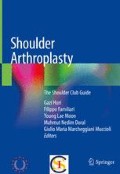Abstract
The glenohumeral joint is the most mobile joint in the human body. The stability of the joint is provided by a combination of both static and dynamic factors. The bones, the ligaments, and the capsule represent the static stabilizers. The ligamento-capsular complex is crucial to the end range of motion when they are stretched [1]. The rotator cuff muscles are m. supraspinatus, m. infraspinatus, m. teres minor, and m. subscapularis and are the dynamic stabilizers. They provide “contraction-compression” model of stability [2]. The contraction both centers the head and compresses it against the glenoid fossa. They are most effective in the mid- and end-range of motion. Their action is best described as stability by balancing the force couples. Infraspinatus, teres minor, and subscapularis provide a net inferiorly directed force; deltoid muscle provides a net superiorly directed force resulting in net force balance in coronal plane. In the analogous manner, subscapularis is balancing infraspinatus and teres minor muscles in sagittal plane [3]. The rotator cuff actively stabilizes and opposes upward motion of the humeral head during contraction of the deltoid muscle.
Access this chapter
Tax calculation will be finalised at checkout
Purchases are for personal use only
References
Lee SB, Kim KJ, O’Driscoll SW, Morrey BF, An KN. Dynamic glenohumeral stability provided by the rotator cuff muscles in the mid-range and end-range of motion: a study in cadavera. J Bone Joint Surg Am. 2000;82(6):849–57.
Lippitt S, Matsen F. Mechanisms of glenohumeral joint stability. Clin Orthop Relat Res. 1993;(291):20–8. http://www.ncbi.nlm.nih.gov/pubmed/8504601.
Burkhart SS. Fluoroscopic comparison of kinematic patterns in massive rotator cuff tears: a suspension bridge model. Clin Orthop Relat Res. 1992;284(284):144–52.
Dines DM, Moynihan DP, Dines J, McCann P. Irreparable rotator cuff tears: what to do and when to do it; the surgeon’s dilemma. J Bone Joint Surg Am. 2006;88(10):2294–302. http://www.ncbi.nlm.nih.gov/pubmed/17472288, http://www.ncbi.nlm.nih.gov/pubmed/17066569.
Neer CS 2nd, Watson KC, Stanton FJ, et al. Recent experience in total shoulder replacement. J Bone Joint Surg Am. 1982;64(3):319–37. http://ovidsp.ovid.com/ovidweb.cgi?T=JS&PAGE=reference&D=emed2&NEWS=N&AN=12153526.
Cofield RH. Total shoulder arthroplasty with the Neer prosthesis. J Bone Joint Surg Am. 1984;66(6):899–906.
Grammont P, Trouilloud P, Laffay JPDX. Concept study and realization of a new total shoulder prosthesis [French]. Rhumatologie. 1987;39:407–18.
Smithers CJ, Young AA, Walch G. Reverse shoulder arthroplasty. Curr Rev Musculoskelet Med. 2011;4(4):183–90.
Jazayeri R, Kwon YW. Evolution of the reverse total shoulder prosthesis. Bull NYU Hosp Joint Dis. 2011;69(1):50–5.
Nyffeler RW, Werner CML, Simmen BR, Gerber C. Analysis of a retrieved Delta III total shoulder prosthesis. J Bone Joint Surg. 2004;86(8):1187–91. http://www.bjj.boneandjoint.org.uk/cgi/doi/10.1302/0301-620X.86B8.15228.
Grammont PM, Baulot E. The classic: Delta shoulder prosthesis for rotator cuff rupture. 1993. Clin Orthop Relat Res. 2011;469(9):2424.
Gerber C, Pennington S, Nyffeler RW. Reverse total shoulder arthroplasty. J Am Acad Orthop Surg. 2009;17(5):284–95.
Nyffeler RW, Werner CML, Gerber C. Biomechanical relevance of glenoid component positioning in the reverse Delta III total shoulder prosthesis. J Shoulder Elbow Surg. 2005;14(5):524–8.
Gutiérrez S. The biomechanics of reverse shoulder arthroplasty. 2009. http://scholarcommons.usf.edu/etd, http://scholarcommons.usf.edu/etd/4800.
Farshad M, Gerber C. Reverse total shoulder arthroplasty—from the most to the least common complication. Int Orthop. 2010;34(8):1075–82.
Boileau P. Complications and revision of reverse total shoulder arthroplasty. Orthop Traumatol Surg Res. 2016;102(1):S33–43. https://doi.org/10.1016/j.otsr.2015.06.031.
Guery J, Fevard L, Sirveaux F, Oudet D, Mole D, Walch G. Reverse total shoulder arthroplasty. J Bone Joint Surg Am. 2006;88(8):1742–7. http://content.wkhealth.com/linkback/openurl?sid=WKPTLP:landingpage&an=00004623-200608000-00008.
Gutiérrez S, Keller TS, Levy JC, Lee WE, Luo ZP. Hierarchy of stability factors in reverse shoulder arthroplasty. Clin Orthop Relat Res. 2008;466(3):670–6.
Henninger HB, Barg A, Anderson AE, Bachus KN, Tashjian RZ, Burks RT. Effect of deltoid tension and humeral version in reverse total shoulder arthroplasty: a biomechanical study. J Shoulder Elbow Surg. 2012;21(4):483–90. https://doi.org/10.1016/j.jse.2011.01.040.
Walker DR, Struk AM, Matsuki K, Wright TW, Banks SA. How do deltoid muscle moment arms change after reverse total shoulder arthroplasty? J Shoulder Elbow Surg. 2016;25(4):581–8. https://doi.org/10.1016/j.jse.2015.09.015.
Author information
Authors and Affiliations
Editor information
Editors and Affiliations
Rights and permissions
Copyright information
© 2020 Springer Nature Switzerland AG
About this chapter
Cite this chapter
Bytyqi, D., Kafeloff, M., Shabani, B. (2020). Biomechanics of rTSA. In: Huri, G., Familiari, F., Moon, Y.L., Doral, M.N., Marcheggiani Muccioli, G.M. (eds) Shoulder Arthroplasty. Springer, Cham. https://doi.org/10.1007/978-3-030-19285-3_4
Download citation
DOI: https://doi.org/10.1007/978-3-030-19285-3_4
Publisher Name: Springer, Cham
Print ISBN: 978-3-030-19284-6
Online ISBN: 978-3-030-19285-3
eBook Packages: MedicineMedicine (R0)

